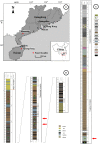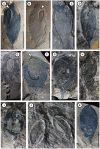Eocene Podocarpium (Leguminosae) from South China and its biogeographic implications
- PMID: 26579179
- PMCID: PMC4630573
- DOI: 10.3389/fpls.2015.00938
Eocene Podocarpium (Leguminosae) from South China and its biogeographic implications
Erratum in
-
Corrigendum: Eocene Podocarpium (Leguminosae) from South China and its biogeographic implications.Front Plant Sci. 2015 Nov 17;6:1036. doi: 10.3389/fpls.2015.01036. eCollection 2015. Front Plant Sci. 2015. PMID: 26635854 Free PMC article.
Abstract
Podocarpium A. Braun ex Stizenberger is one of the most common legumes in the Neogene of Eurasia, including fossil fruits, seeds, leaves, and possible flower and pollen grains. This genus is not completely consistent with any extant genera according to gross morphological characters and poorly preserved cuticular structures reported in previous studies. The fossil pods collected from the coal-bearing series of the Changchang Basin of Hainan Island and Maoming Basin of Guangdong, South China, are examined by morphologically comparative work, with special reference to venation patterns and placental position. These distinctive features, as well as the ovule development of pods from different developmental stages and the epidermal structure of the pods, as distinguished from previous records lead to the conclusion that these fossils can be recognized as a new species of Podocarpium, P. eocenicum sp. nov. This new discovery indicates that Podocarpium had arrived in South China by the Eocene. Investigation on the fossil records of this extinct genus shows that P. eocenicum is the earliest and lowest latitude fossil data. The possible occurrence pattern of this genus is revealed as follows: Podocarpium had distributed in the South China at least in the middle Eocene, and then migrated to Europe during the Oligocene; in the Miocene this genus reached its peak in Eurasia, spreading extensively across subtropical areas to warm temperate areas; finally, Podocarpium shrank rapidly and became extinct in Eurasia during the Pliocene.
Keywords: Eocene; Leguminosae; Podocarpium; South China; phytogeography.
Figures






Similar articles
-
Fertile Woodwardia from the middle Eocene of South China and its implications for palaeogeography and palaeoclimate.Plant Divers. 2021 Sep 14;44(6):565-576. doi: 10.1016/j.pld.2021.09.003. eCollection 2022 Nov. Plant Divers. 2021. PMID: 36540713 Free PMC article.
-
Leaves and fruits of Bauhinia (Leguminosae, Caesalpinioideae, Cercideae) from the Oligocene Ningming Formation of Guangxi, South China and their biogeographic implications.BMC Evol Biol. 2014 Apr 24;14:88. doi: 10.1186/1471-2148-14-88. BMC Evol Biol. 2014. PMID: 24758153 Free PMC article.
-
Winged fruits and associated leaves of Shorea (Dipterocarpaceae) from the Late Eocene of South China and their phytogeographic and paleoclimatic implications.Am J Bot. 2013 Mar;100(3):574-81. doi: 10.3732/ajb.1200397. Epub 2013 Feb 27. Am J Bot. 2013. PMID: 23445828
-
Bird evolution in the Eocene: climate change in Europe and a Danish fossil fauna.Biol Rev Camb Philos Soc. 2006 Nov;81(4):483-99. doi: 10.1017/S146479310600707X. Epub 2006 Aug 8. Biol Rev Camb Philos Soc. 2006. PMID: 16893476 Review.
-
Ceratopetalum (Cunoniaceae) fruits of Australasian affinity from the early Eocene Laguna del Hunco flora, Patagonia, Argentina.Ann Bot. 2017 Mar 1;119(4):507-516. doi: 10.1093/aob/mcw283. Ann Bot. 2017. PMID: 28110267 Free PMC article. Review.
Cited by
-
Fossil samaras of Ailanthus from South China and their phytogeographic implications.iScience. 2022 Jul 14;25(8):104757. doi: 10.1016/j.isci.2022.104757. eCollection 2022 Aug 19. iScience. 2022. PMID: 35942093 Free PMC article.
-
Megafossils of Betulaceae from the Oligocene of Qaidam Basin and their paleoenvironmental and phytogeographic implications.Plant Divers. 2023 Mar 30;46(1):101-115. doi: 10.1016/j.pld.2023.03.007. eCollection 2024 Jan. Plant Divers. 2023. PMID: 38343597 Free PMC article.
-
Cenozoic plant diversity of Yunnan: A review.Plant Divers. 2016 Dec 14;38(6):271-282. doi: 10.1016/j.pld.2016.11.004. eCollection 2016 Dec. Plant Divers. 2016. PMID: 30159478 Free PMC article. Review.
References
-
- Aleksandrova G. N., Kodrul T. M., Jin J. H. (2015). Palynological and paleobotanical investigations of Paleogene sections in the Maoming Basin, South China. Stratigr. Geol. Correl. 23 300–325. 10.1134/S0869593815030028 - DOI
-
- Aleksandrova G. N., Kodrul T. M., Liu X. Y., Song Y. S., Jin J. H. (2012). “Palynological characteristics of the upper part of the Youganwo Formation and lower part of the Huangniuling Formation, Maoming Basin, South China,” in Proceedings of the 2nd Sino-Russian Seminar on Evolution and Development of Eastern Asia Flora based on Palaeobotanical Data (Guangzhou: School of Life Sciences, Sun Yat-sen University; ), 3–15.
-
- Awasthi N. (1992). “India fossil legumes,” in Advances in Legume Systematics, part 4. The Fossil Record, eds Herendeen P. S., Dilcher D. L. (Kew: Royal Botanic Gardens; ), 225–250.
-
- Barbu Z. I. (1936). Flora fosilä dela Muereasca des Sus, judeţul Vîlcea. Acad. Rom. Mém. Secţ. Şt. III 11 363–386.
-
- Bawa K. S., Webb C. J. (1984). Flower, fruit and seed abortion in tropical forest trees: implications for the evolution of paternal and maternal reproductive patterns. Am. J. Bot. 71 736–751. 10.2307/24433£71 - DOI
LinkOut - more resources
Full Text Sources
Other Literature Sources

